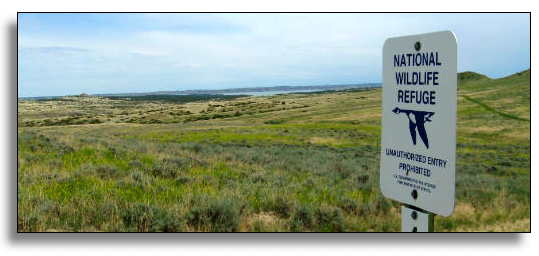

Management of Wildlife on Federal Lands
However, Nie et al. (2017), in an extensive
review of the U. S. Constitution and of laws governing federal
land-management agencies, concluded “the states’ trust
responsibilities for wildlife are subordinate to the federal government’s
statutory and trust obligations over federal lands and their integral
resources” including wildlife. The National Wildlife Refuge Administration Act clarifies that actions on a refuge must be compatible with the mission of the Refuge System and with the refuge’s purposes stated in its establishing legislation. Refuge actions shall provide for conservation of fish, wildlife and plants, and their habitat and ensure biological integrity, diversity and environmental health of the Refuge System, for the benefit of present and future generations of Americans. A refuge may “restore wildlife where appropriate.” Notably, a federal refuge must “ensure effective coordination, interaction, and cooperation” with adjacent landowners and with the state in which the refuge is located. However, this instruction does not absolve the Fish and Wildlife Service from fulfilling its mandates, noted above. A refuge must cooperate with state and local dictates only “to the extent practicable”. Restoring bison on the CMR would contribute
to the mission of the Refuge System in that the Department of
Interior’s Bison Conservation Initiative’s goals include
the maintenance of wildness and genetic diversity in large, wide-ranging
bison herds on large landscapes. “Perhaps the greatest conservation
challenge that bison face is the lack of large blocks of habitat.”
(NPS 2020). There is no indication that that restoring bison would be biologically inappropriate. In the Department of Interior’s Bison Conservation Initiative, its goal and need for large bison herds on large landscapes would be greatly enhanced with restoration of bison on the CMR. The CMR is the largest federal refuge within the historic range of plains bison. Despite these potential contributions to refuge
goals and to the mission of the Refuge System, the CMR Plan concludes:
“The Service will not consider reintroducing bison on the
refuge unless Montana Fish, Wildlife & Parks initiates an
effort.” and that “any proposal for bison restoration
would be conducted by a public process led by Montana Fish, Wildlife
& Parks.” This is an abdication of federal statutory
and public trust responsibilities for federal lands and resources,
despite the state’s long failure, in not restoring wild
bison, to fulfill its own Constitutional mandate and public trust
responsibilities to the people of Montana. Allowing the CMR to manipulate its habitat
without bison is a disingenuous proposition. The Refuge is denied
one of its most important “habitat managers”. The
habitat impacts of wild bison cannot be duplicated by human activity.
For examples, the CMR cannot produce thousands of bison wallows
as habitat for plants and animals, cannot seasonally distribute
shed bison hair for use by nesting birds, cannot duplicate the
effects of bison grazing distributed across space and time in
natural ways. CMR 2010. Comprehensive Conservation Plan and Environmental Impact Statement, Charles M. Russell National Wildlife Refuge, UL Bend National Wildlife Refuge. (The Draft version is cited here.) Nie, M., C. Barns, J. Haber, J. Joly, K. Pitt and S. Zellmer. 2017. Fish and wildlife management of federal lands: Debunking state supremacy. Environmental Law 47 (4): 1-126. NPS 2020. The quote is from: nps.gov/subjects/bison/what-we-de.htm.
|
|
Site designed and maintained by Kathryn QannaYahu Kern